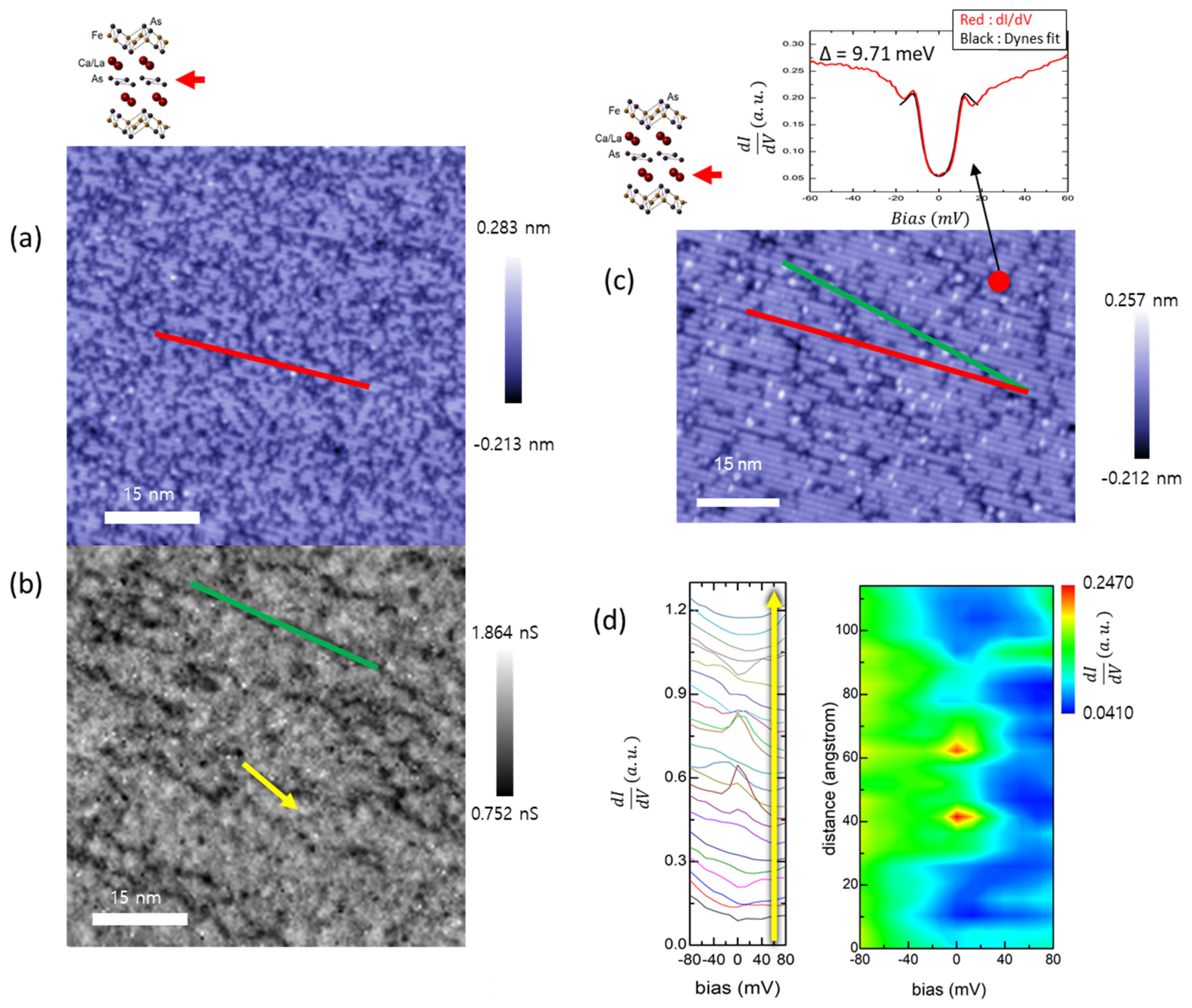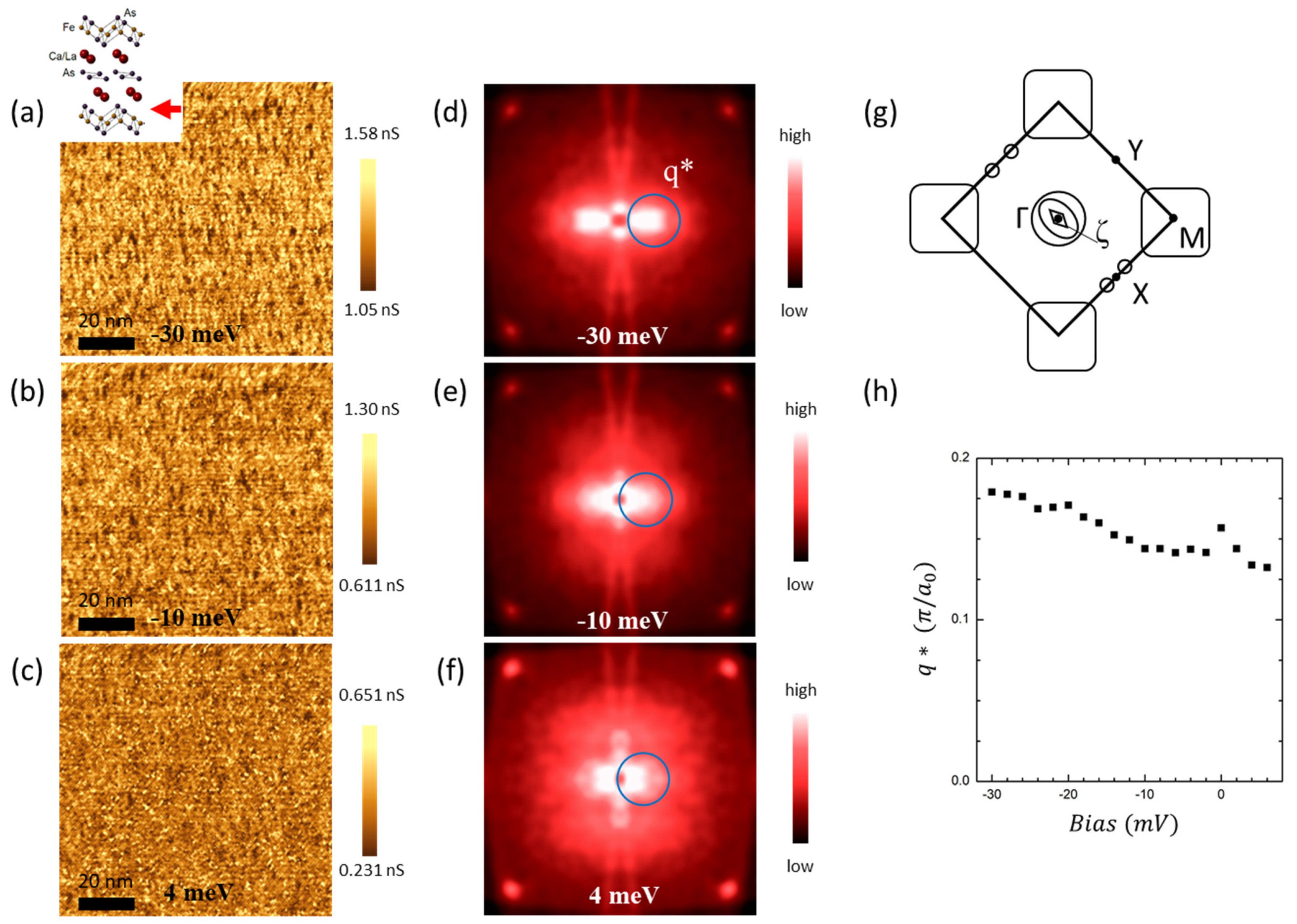Observations of Nematicity, Dopants, and Zero-Bias Conductance Peaks for the Ca0.9La0.1FeAs2 Superconductor
Abstract
:1. Introduction
2. Materials and Methods
3. Results and Discussion
4. Conclusions
Supplementary Materials
Author Contributions
Funding
Acknowledgments
Conflicts of Interest
References
- Paglione, J.; Greene, R.L. High-Temperature Superconductivity in Iron-Based Materials. Nat. Phys. 2010, 6, 645–658. [Google Scholar] [CrossRef]
- Yu, J.; Liu, T.; Pan, B.-J.; Ruan, B.-B.; Wang, X.-C.; Mu, Q.-G.; Zhao, K.; Chen, G.-F.; Ren, Z.-A. Discovery of a Novel 112-Type Iron-Pnictide and La-Doping Induced Superconductivity in Eu1−xLaxFeAs2 (x = 0–0.15). Sci. Bull. 2017, 62, 218–221. [Google Scholar] [CrossRef] [PubMed]
- Katayama, N.; Kudo, K.; Onari, S.; Mizukami, T.; Sugawara, K.; Sugiyama, Y.; Kitahama, Y.; Iba, K.; Fujimura, K.; Nishimoto, N.; et al. Superconductivity in Ca1−xLaxFeAs2: A Novel 112-Type Iron Pnictide with Arsenic Zigzag Bonds. J. Phys. Soc. Japan 2013, 82, 123702. [Google Scholar] [CrossRef]
- Yakita, H.; Ogino, H.; Okada, T.; Yamamoto, A.; Kishio, K.; Tohei, T.; Ikuhara, Y.; Gotoh, Y.; Fujihisa, H.; Kataoka, K.; et al. A New Layered Iron Arsenide Superconductor: (Ca, Pr) FeAs2. J. Am. Chem. Soc. 2014, 136, 846–849. [Google Scholar] [CrossRef] [PubMed]
- Ma, J.-Z.; van Roekeghem, A.; Richard, P.; Liu, Z.-H.; Miao, H.; Zeng, L.-K.; Xu, N.; Shi, M.; Cao, C.; He, J.-B.; et al. Correlation-Induced Self-Doping in the Iron-Pnictide Superconductor Ba2Ti2Fe2As4O. Phys. Rev. Lett. 2014, 113, 266407. [Google Scholar] [CrossRef]
- Shen, X.P.; Chen, S.D.; Ge, Q.Q.; Ye, Z.R.; Chen, F.; Xu, H.C.; Tan, S.Y.; Niu, X.H.; Fan, Q.; Xie, B.P.; et al. Electronic Structure of Ca10(Pt4As8)(Fe2− xPtxAs2)5 with Metallic Pt4As8 Layers: An Angle-Resolved Photoemission Spectroscopy Study. Phys. Rev. B 2013, 88, 115124. [Google Scholar] [CrossRef]
- Ni, N.; Allred, J.M.; Chan, B.C.; Cava, R.J. High Tc Electron Doped Ca10(Pt3As8)(Fe2As2)5 and Ca10(Pt4As8)(Fe2As2)5 Superconductors with Skutterudite Intermediary Layers. Proc. Natl. Acad. Sci. USA 2011, 108, E1019–E1026. [Google Scholar]
- Warren, W.W., Jr.; Walstedt, R.E.; Brennert, G.F.; Cava, R.J.; Tycko, R.; Bell, R.F.; Dabbagh, G. Cu Spin Dynamics and Superconducting Precursor Effects in Planes above Tc in YBa2Cu3O6.7. Phys. Rev. Lett. 1989, 62, 1193. [Google Scholar] [CrossRef]
- Basov, D.N.; Timusk, T. Electrodynamics of High-Tc Superconductors. Rev. Mod. Phys. 2005, 77, 721. [Google Scholar] [CrossRef]
- Kordyuk, A.A. Pseudogap from ARPES Experiment: Three Gaps in Cuprates and Topological Superconductivity. Low Temp. Phys. 2015, 41, 319–341. [Google Scholar] [CrossRef]
- Blanco-Canosa, S.; Frano, A.; Schierle, E.; Porras, J.; Loew, T.; Minola, M.; Bluschke, M.; Weschke, E.; Keimer, B.; Le Tacon, M. Resonant X-ray Scattering Study of Charge-Density Wave Correlations in YBa2Cu3O6+X. Phys. Rev. B 2014, 90, 54513. [Google Scholar] [CrossRef] [Green Version]
- Comin, R.; Frano, A.; Yee, M.M.; Yoshida, Y.; Eisaki, H.; Schierle, E.; Weschke, E.; Sutarto, R.; He, F.; Soumyanarayanan, A.; et al. Charge Order Driven by Fermi-Arc Instability in Bi2Sr2−XLaxCuO6+δ. Science 2014, 343, 390–392. [Google Scholar] [CrossRef] [PubMed]
- da Silva Neto, E.H.; Aynajian, P.; Frano, A.; Comin, R.; Schierle, E.; Weschke, E.; Gyenis, A.; Wen, J.; Schneeloch, J.; Xu, Z.; et al. Ubiquitous Interplay between Charge Ordering and High-Temperature Superconductivity in Cuprates. Science 2014, 343, 393–396. [Google Scholar] [CrossRef] [PubMed]
- Loeser, A.G.; Shen, Z.-X.; Dessau, D.S.; Marshall, D.S.; Park, C.H.; Fournier, P.; Kapitulnik, A. Excitation Gap in the Normal State of Underdoped Bi2Sr2CaCu2O8+δ. Science 1996, 273, 325–329. [Google Scholar] [CrossRef] [PubMed]
- Ding, H.; Yokoya, T.; Campuzano, J.C.; Takahashi, T.; Randeria, M.; Norman, M.R.; Mochiku, T.; Kadowaki, K.; Giapintzakis, J. Spectroscopic Evidence for a Pseudogap in the Normal State of Underdoped High-Tc Superconductors. Nature 1996, 382, 51–54. [Google Scholar] [CrossRef]
- Norman, M.R.; Ding, H.; Randeria, M.; Campuzano, J.C.; Yokoya, T.; Takeuchi, T.; Takahashi, T.; Mochiku, T.; Kadowaki, K.; Guptasarma, P.; et al. Destruction of the Fermi Surface in Underdoped High-Tc Superconductors. Nature 1998, 392, 157–160. [Google Scholar] [CrossRef]
- Shen, K.M.; Ronning, F.; Lu, D.H.; Baumberger, F.; Ingle, N.J.C.; Lee, W.S.; Meevasana, W.; Kohsaka, Y.; Azuma, M.; Takano, M.; et al. Nodal Quasiparticles and Antinodal Charge Ordering in Ca2−XNaxCuO2Cl2. Science 2005, 307, 901–904. [Google Scholar] [CrossRef]
- Liu, X.; Liu, D.F.; Zhao, L.; Guo, Q.; Mu, Q.G.; Chen, D.Y.; Shen, B.; Yi, H.M.; Huang, J.W.; He, J.F.; et al. Fermi Surface and Band Structure of (Ca, La)FeAs2 Superconductor from Angle-Resolved Photoemission Spectroscopy. Chinese Phys. Lett. 2013, 30, 127402. [Google Scholar] [CrossRef]
- Wu, X.; Le, C.; Liang, Y.; Qin, S.; Fan, H.; Hu, J. Effect of As-Chain Layers in CaFeAs 2. Phys. Rev. B 2014, 89, 205102. [Google Scholar] [CrossRef]
- Li, M.Y.; Liu, Z.T.; Zhou, W.; Yang, H.F.; Shen, D.W.; Li, W.; Jiang, J.; Niu, X.H.; Xie, B.P.; Sun, Y.; et al. Significant Contribution of As 4p Orbitals to the Low-Lying Electronic Structure of the 112-Type Iron-Based Superconductor Ca0.9La0.1FeAs2. Phys. Rev. B 2015, 91, 045112. [Google Scholar] [CrossRef]
- Jiang, S.; Liu, C.; Cao, H.; Birol, T.; Allred, J.M.; Tian, W.; Liu, L.; Cho, K.; Krogstad, M.J.; Ma, J.; et al. Structural and Magnetic Phase Transitions in Ca0.73La0.27FeA2 with Electron-Overdoped FeAs Layers. Phys. Rev. B 2016, 93, 54522. [Google Scholar] [CrossRef] [Green Version]
- Wu, X.; Qin, S.; Liang, Y.; Le, C.; Fan, H.; Hu, J. CaFeAs2: A Staggered Intercalation of Quantum Spin Hall and High-Temperature Superconductivity. Phys. Rev. B 2015, 91, 81111. [Google Scholar] [CrossRef]
- Liu, Z.T.; Xing, X.Z.; Li, M.Y.; Zhou, W.; Sun, Y.; Fan, C.C.; Yang, H.F.; Liu, J.S.; Yao, Q.; Li, W.; et al. Observation of the Anisotropic Dirac Cone in the Band Dispersion of 112-Structured Iron-Based Superconductor Ca0.9La0.1FeAs2. Appl. Phys. Lett. 2016, 109, 42602. [Google Scholar] [CrossRef]
- Kim, J.-J.; Joo, S.H.; Lee, K.S.; Yoo, J.H.; Park, M.S.; Kwak, J.S.; Lee, J. Improved Design for a Low Temperature Scanning Tunneling Microscope with an in Situ Tip Treatment Stage. Rev. Sci. Instrum. 2017, 88, 43702. [Google Scholar] [CrossRef] [PubMed]
- Yin, Y.; Zech, M.; Williams, T.L.; Wang, X.F.; Wu, G.; Chen, X.H.; Hoffman, J.E. Scanning Tunneling Spectroscopy and Vortex Imaging in the Iron Pnictide Superconductor BaFe1.8Co0.2As2. Phys. Rev. Lett. 2009, 102, 97002. [Google Scholar] [CrossRef] [PubMed]
- Zou, Q.; Wu, Z.; Fu, M.; Zhang, C.; Rajput, S.; Wu, Y.; Li, L.; Parker, D.S.; Kang, J.; Sefat, A.S.; et al. Effect of Surface Morphology and Magnetic Impurities on the Electronic Structure in Cobalt-Doped BaFe2As2 Superconductors. Nano Lett. 2017, 17, 1642–1647. [Google Scholar] [CrossRef]
- Boyer, M.C.; Chatterjee, K.; Wise, W.D.; Chen, G.F.; Luo, J.L.; Wang, N.L.; Hudson, E.W. Scanning Tunneling Microscopy of the 32 K Superconductor (Sr1−XKX)Fe2As2. arXiv 2008, arXiv:0806.4400. [Google Scholar]
- Niestemski, F.C.; Nascimento, V.B.; Hu, B.; Plummer, W.; Gillett, J.; Sebastian, S.; Wang, Z.; Madhavan, V. Unveiling the Atomic and Electronic Structure at the Surface of the Parent Pnictide SrFe2As2. arXiv 2009, arXiv:0906.2761. [Google Scholar]
- Dreyer, M.; Gubrud, M.; Saha, S.; Butch, N.P.; Kirshenbaum, K.; Paglione, J. Sr Adatoms on As Bridge Positions on SrFe2As2 Observed by Scanning Tunneling Microscopy at 4.2 K. J. Phys. Condens. Matter 2011, 23, 265702. [Google Scholar] [CrossRef]
- Song, C.-L.; Yin, Y.; Zech, M.; Williams, T.; Yee, M.M.; Chen, G.-F.; Luo, J.-L.; Wang, N.-L.; Hudson, E.W.; Hoffman, J.E. Dopant Clustering, Electronic Inhomogeneity, and Vortex Pinning in Iron-Based Superconductors. Phys. Rev. B 2013, 87, 214519. [Google Scholar] [CrossRef]
- Jandke, J.; Wild, P.; Schackert, M.; Suga, S.; Kobayashi, T.; Miyasaka, S.; Tajima, S.; Wulfhekel, W. Scanning Tunneling Spectroscopy on SrFe2(As1−xPx)2. Phys. Rev. B 2016, 93, 104528. [Google Scholar] [CrossRef]
- Chuang, T.-M.; Allan, M.P.; Lee, J.; Xie, Y.; Ni, N.; Bud’ko, S.L.; Boebinger, G.S.; Canfield, P.C.; Davis, J.C. Nematic Electronic Structure in the “Parent” State of the Iron-Based Superconductor Ca(Fe1−xCox)2As2. Science 2010, 327, 181–184. [Google Scholar] [CrossRef]
- Zeljkovic, I.; Huang, D.; Song, C.-L.; Lv, B.; Chu, C.-W.; Hoffman, J.E. Nanoscale Surface Element Identification and Dopant Homogeneity in the High-T c Superconductor PrxCa1−xFe2As2. Phys. Rev. B 2013, 87, 201108. [Google Scholar] [CrossRef] [Green Version]
- Gofryk, K.; Pan, M.; Cantoni, C.; Saparov, B.; Mitchell, J.E.; Sefat, A.S. Local Inhomogeneity and Filamentary Superconductivity in Pr-Doped CaFe2As2. Phys. Rev. Lett. 2014, 112, 47005. [Google Scholar] [CrossRef] [PubMed]
- Wilfert, S.; Schmitt, M.; Schmidt, H.; Mauerer, T.; Sessi, P.; Wang, H.; Mao, Q.; Fang, M.; Bode, M. Scanning Tunneling Microscopy and Spectroscopy Studies of the Heavy-Electron Superconductor TlNi2Se2. Phys. Rev. B 2018, 97, 14514. [Google Scholar] [CrossRef]
- Lang, K.M.; Madhavan, V.; Hoffman, J.E.; Hudson, E.W.; Eisaki, H.; Uchida, S.; Davis, J.C. Imaging the granular structure of high-Tc superconductivity in underdoped Bi2Sr2CaCu2O8+δ. Nature 2002, 415, 412–416. [Google Scholar] [CrossRef] [PubMed]
- Wang, Z.; Walkup, D.; Maximenko, Y.; Zhou, W.; Hogan, T.; Wang, Z.; Wilson, S.D.; Madhavan, V. Doping Induced Mott Collapse and Possible Density Wave Instabilities in (Sr1−xLax)3Ir2O7. npj Quantum Mater. 2019, 4, 43. [Google Scholar] [CrossRef]
- McElroy, K.; Lee, J.; Slezak, J.A.; Lee, D.H.; Eisaki, H.; Uchida, S.; Davis, J.C. Atomic-Scale Sources and Mechanism of Nanoscale Electronic Disorder in Bi2Sr2CaCu2O8+δ. Science 2005, 309, 1048–1052. [Google Scholar] [CrossRef] [PubMed]
- Johnston, D.C. The Puzzle of High Temperature Superconductivity in Layered Iron Pnictides and Chalcogenides. Adv. Phys. 2010, 59, 803–1061. [Google Scholar] [CrossRef]
- Hirschfeld, P.J.; Korshunov, M.M.; Mazin, I.I. Gap Symmetry and Structure of Fe-Based Superconductors. Rep. Prog. Phys. 2011, 74, 124508. [Google Scholar] [CrossRef]
- Gao, M.; Ma, F.; Lu, Z.-Y.; Xiang, T. Surface Structures of Ternary Iron Arsenides AFe2As2 (A = Ba, Sr, or Ca). Phys. Rev. B 2010, 81, 193409. [Google Scholar] [CrossRef] [Green Version]




Disclaimer/Publisher’s Note: The statements, opinions and data contained in all publications are solely those of the individual author(s) and contributor(s) and not of MDPI and/or the editor(s). MDPI and/or the editor(s) disclaim responsibility for any injury to people or property resulting from any ideas, methods, instructions or products referred to in the content. |
© 2023 by the authors. Licensee MDPI, Basel, Switzerland. This article is an open access article distributed under the terms and conditions of the Creative Commons Attribution (CC BY) license (https://creativecommons.org/licenses/by/4.0/).
Share and Cite
Kim, J.-J.; Park, M.S.; Lee, K.S.; Joo, S.H.; Yoo, J.H.; Bhoi, D.; Min, B.H.; Kim, K.H.; Lee, J. Observations of Nematicity, Dopants, and Zero-Bias Conductance Peaks for the Ca0.9La0.1FeAs2 Superconductor. Nanomaterials 2023, 13, 622. https://doi.org/10.3390/nano13040622
Kim J-J, Park MS, Lee KS, Joo SH, Yoo JH, Bhoi D, Min BH, Kim KH, Lee J. Observations of Nematicity, Dopants, and Zero-Bias Conductance Peaks for the Ca0.9La0.1FeAs2 Superconductor. Nanomaterials. 2023; 13(4):622. https://doi.org/10.3390/nano13040622
Chicago/Turabian StyleKim, Jae-Joon, Min Seok Park, Kyoung Seok Lee, Sang Hyun Joo, Jung Hoon Yoo, Dilip Bhoi, Byeong Hun Min, Kee Hoon Kim, and Jinho Lee. 2023. "Observations of Nematicity, Dopants, and Zero-Bias Conductance Peaks for the Ca0.9La0.1FeAs2 Superconductor" Nanomaterials 13, no. 4: 622. https://doi.org/10.3390/nano13040622




